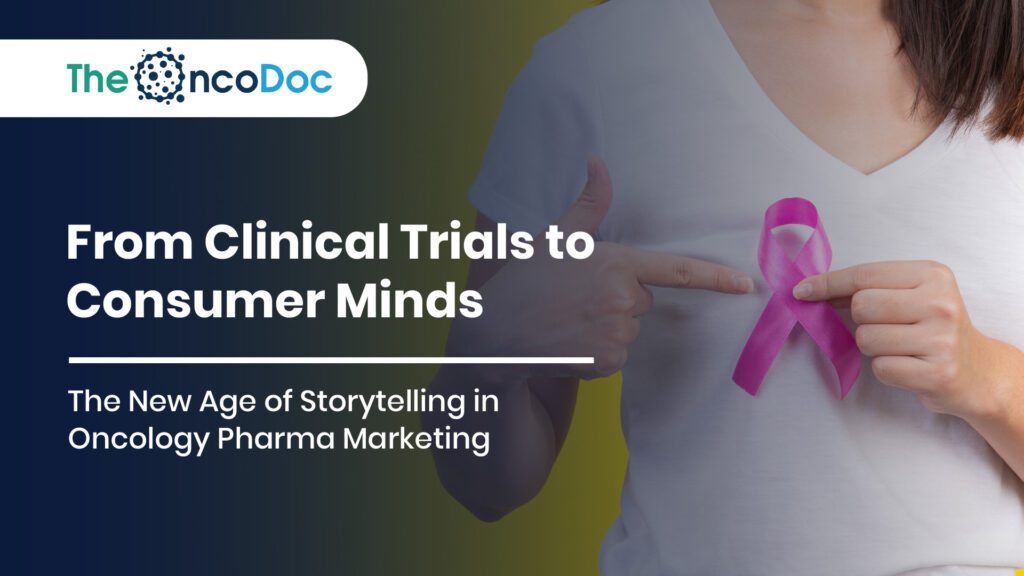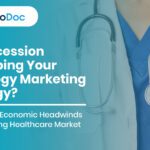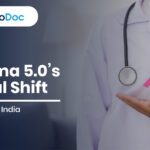Introduction: Science Meets Story in the Oncology Arena
In the age of instant information, pharma companies face a daunting challenge, how to communicate highly technical, often life-altering oncology science in a way that’s accessible, empathetic, and impactful. Gone are the days when a clinical trial press release or medical journal ad was enough. The new frontier of oncology pharma marketing is consumerized storytelling, where science walks hand in hand with emotion, narrative, and personalization.
Today’s empowered patients are not passive recipients of care, they are active decision-makers, researchers, caregivers, and survivors. Pharma brands that recognize this shift are leveraging consumer-style tactics such as video storytelling, behavioral psychology, digital engagement, and AI-driven personalization to create powerful communication bridges between clinical innovation and the real world.
This article maps this evolution, from lab bench to living room, and how brands are turning data into dialogue, molecules into meaning, and campaigns into community movements.
1. From Trial Results to Transformational Narratives
Clinical trials are complex. Their statistical jargon, “progression-free survival”, “hazard ratios”, “double-blind, placebo-controlled”- can be alienating even for educated audiences. Pharma brands are now translating these outcomes into transformational patient narratives.
For instance, instead of stating:
“Trial ABC showed a 34% reduction in tumor size over 6 months in HER2+ patients…”,
modern campaigns might say:
“Priya, 42, had almost given up after multiple failed treatments. A new HER2-targeted therapy helped her reclaim her life in just months. Here’s her story…”
These story-led campaigns don’t just inform, they inspire trust. Audiences relate to real faces, not graphs.
To ensure scientific accuracy, brands are now collaborating with medical writers and data visualization experts to “translate” trial endpoints into digestible micro-content. Infographics showing survival curves are simplified into storytelling arcs with captions like “More time for moments that matter” or “50% more birthdays celebrated.” By pairing each clinical milestone with a human counterpart (e.g., a grandfather attending his granddaughter’s graduation), pharma companies inject empathy into evidence.
Moreover, storytelling isn’t limited to successes. Campaigns now explore “real but hopeful” narratives, those still in treatment, facing rare cancer types, or navigating clinical trial uncertainty. These nuanced voices reflect authenticity, which 76% of patients value over polished brand marketing, according to a 2024 McKinsey survey.
🧠 Key Insight: AI models now analyze trial data and patient personas to suggest “narrative hooks” that resonate with different psychographic segments (e.g., hopeful caregiver vs skeptical patient).
2. Bridging the Knowledge Gap with Story-Based Content
Research shows that narrative formats enhance recall by 22% over purely informational ones in healthcare marketing.
Pharma marketers are now creating:
- Mini docuseries featuring survivors explaining their cancer journey and treatment choices.
- “Day in the life” reels of patients on new immunotherapy regimens, showing real impact.
- Side-by-side “Then & Now” testimonials, reflecting transformation over months.
These aren’t just ads, they’re health literacy tools. By framing oncology drugs as part of a larger recovery story, pharma brands help patients visualize themselves as active participants in their care.
Additionally, brands are curating progressive content series that evolve with the patient’s journey. For example, a newly diagnosed user may first receive a short animated video explaining their cancer type. If they interact with it, the next email or push notification delivers a survivor’s vlog on treatment experiences. Later, educational reels on managing side effects are queued based on predictive AI models that anticipate pain points.
A novel approach includes voice notes from actual patients, embedded into awareness campaigns on WhatsApp or podcast series, making storytelling more intimate. Some pharma-led platforms even offer interactive “choose your path” narratives, where users guide a fictional patient through diagnosis and treatment choices, educating while empowering.
3. Micro-Campaigns That Follow the Patient’s Emotional Curve
Modern oncology marketing understands that treatment decisions are emotional before they’re rational. A new wave of content mapping follows the patient’s emotional curve, from diagnosis shock to treatment doubt, side-effect anxiety, and survivorship pride.
At each stage, pharma deploys emotion-matched storytelling, such as:
- Interactive animations simplifying complex MOAs (Mechanism of Action).
- Reassuring caregiver videos for the post-chemotherapy fatigue phase.
- Uplifting social content featuring cancer-free anniversary celebrations.
These micro-campaigns don’t just follow the emotional curve, they adapt in real-time. AI tools now analyze user sentiment from previous campaign interactions. If a patient frequently clicks on hopeful stories but skips technical updates, the system prioritizes positive content. Conversely, a user engaging with research summaries may receive deeper medical insights.
Campaigns also use time-based emotional modeling. For example, three weeks post-chemotherapy (a period known for fatigue and isolation), the system may automatically send uplifting recovery stories or peer support invites. This shift from static drip campaigns to responsive storytelling ecosystems marks a breakthrough in empathy-powered pharma marketing.
This style of emotional storytelling results in 3x more engagement and builds sustained brand relationships, not just one-time conversions.
4. Community-First Campaigns: From Audience to Advocacy
Pharma brands are no longer just speaking to patients; they’re building platforms to speak with them. The most effective oncology campaigns today include:
- Survivor clubs that co-create campaign content.
- Caregiver contests where families share tips and win self-care rewards.
- Digital community boards where patients vote on new campaign themes.
This co-creation model fuels a shift from audience to advocacy, where campaign participants become brand ambassadors, trusted voices, and local influencers.
Building community doesn’t just support engagement, it cultivates trust at scale. Brands are now forming “local patient panels”, where selected survivors, caregivers, and advocates are invited to co-develop communication materials in local languages, helping align content with cultural nuances.
One powerful case study involved a cervical cancer campaign in Maharashtra where survivor-led live sessions, conducted in Marathi on Facebook and YouTube, resulted in a 24% spike in local HPV screening inquiries. The authenticity and relatability of peer voices outperformed traditional celebrity-led campaigns.
Pharma marketers are also integrating reward loops in community apps, where engagement in challenges (e.g., attending a virtual cancer Q&A or submitting a daily journal entry) earns recognition badges or screening vouchers. These incentives deepen interaction without compromising ethics.
Ultimately, these platforms do more than amplify awareness, they create a grassroots marketing force rooted in lived experience. When survivors and caregivers feel heard, seen, and valued, they don’t just support a campaign, they champion it.
🧠 Insight: AI-based community listening tools help brands detect trending patient sentiments and micro-influencer voices worth amplifying.
5. Personalization Beyond the Pill
AI allows pharma marketers to deliver Netflix-style personalization, but with purpose.
Using data like:
- Search history (e.g., “natural treatment for lung nodules”),
- Location,
- Age,
- Disease stage, and
- Device language preferences,
Brands now serve tailored narrative experiences:
- A 60-year-old Tamil-speaking woman may receive a survivor-led video on oral cancer in Tamil.
- A 35-year-old male smoker may see a short documentary on targeted therapies with smoking cessation support.
- A newly diagnosed teen’s family may receive child-friendly animations about treatment options.
🎯 Result: Personalized campaigns report 46% higher CTA (Call-to-Action) conversion compared to generic disease awareness ads.
One standout case is a lung cancer awareness campaign in Kerala where local survivor advocates were trained as “community storytellers.” Using a combination of reels, live Zoom events, and vernacular WhatsApp groups, they shared hyperlocal, culturally relevant stories. The campaign drove a 29% increase in early screening bookings in just 60 days.
Pharma companies are also enabling patients to become co-authors of content. Tools allow them to upload their stories, which are then reviewed, curated, and co-branded. These UGC (User Generated Content) stories act as authentic micro-influencer campaigns, often outperforming paid promotions in reach and engagement.
Community-first storytelling isn’t just grassroots, it’s future-proofed brand building. Patients who feel seen and heard are more likely to advocate for that brand in real life and online, closing the loop between marketing and mission.
6. Humanizing HCP Communication with Empathy Frameworks
HCP (Health Care Provider) marketing is shifting too. Oncologists are bombarded with technical content. Pharma brands now deploy empathy-based storytelling to drive impact:
- Case-based learning modules featuring real-life patient progress under the drug.
- “Doctor Diaries”, short videos where HCPs discuss emotional wins and challenges.
- Emotional ROI Dashboards showing not just survival rates but quality-of-life improvements.
By moving from clinical efficacy to human effectiveness, pharma brands earn a deeper place in HCP recall and decision-making.
Pharma reps are also adopting narrative sales decks, which begin with patient experiences before diving into clinical efficacy. For example, a product for metastatic breast cancer might open with “Neeta’s last six months weren’t about survival, they were about dancing at her son’s wedding.”
AI-assisted tools now allow MSLs (Medical Science Liaisons) to generate HCP persona maps, identifying which oncologists prefer emotion-first storytelling and which prefer data-first. This ensures messaging lands with relevance, not resistance.
Even CMEs (Continuing Medical Education) sessions are evolving into case story workshops, where doctors discuss real patient journeys rather than just protocol updates, leading to higher retention and empathy in patient handling.
7. The Power of Platform-First Creativity
Each digital platform is now treated as a unique storytelling canvas:
- Instagram Reels: User-submitted journeys, myth-busting, and brief success tales.
- YouTube: 3-minute explainer series led by oncologists and patients.
- LinkedIn: Thought-leadership on emotional intelligence in cancer care.
- WhatsApp: Tailored narrative journeys guided by a bot according on quiz results.
Pharma brands that tailor stories to platform language and behavior patterns are seeing:
- 2x watch-through rates on Instagram.
- 3x save/share rates for short-form explainers.
- 40% click-through on WhatsApp-powered narratives.
8. From Campaigns to Movements: The Rise of Hashtag Narratives
Some pharma brands are transforming storytelling into social movements, backed by hashtags that spread organically:
- #NotJustSurviving – Stories of long-term wellness beyond remission.
- #CareStartsWithConversation – Campaigns prompting early family discussions.
- #CancerDidNotWin – Survivor-led comeback stories that inspire others to act.
These hashtags act as more than just digital labels, they become rallying cries that unify diverse patient voices under a common emotional theme. Pharma brands are leveraging these narratives to crowdsource authentic content, encouraging patients, caregivers, and healthcare professionals to share their own stories with pride. Many campaigns now feature live hashtag walls during webinars or awareness events, displaying real-time posts and fostering collective identity. Additionally, brands track hashtag performance using sentiment analysis tools, allowing them to refine messaging and elevate the most inspiring user contributions, turning individual voices into a collective, movement-driven impact.
🧠 Impact: User-generated storytelling drives 60% more organic reach than brand-only narratives.
9. Real-Time Campaign Optimization Through Narrative Analytics
AI-driven narrative testing tools now analyze:
- Sentence structure (is it too scientific? too emotional?)
- Tone (is it alarming or inspiring?)
- Imagery (does it feel authentic or stocky?)
Campaigns are A/B tested in real-time, and narratives are automatically adjusted to increase resonance.
For example, if feedback shows confusion around a term like “checkpoint inhibitor”, the system suggests replacing it with “a new type of medicine that helps your immune system fight cancer more strongly.”
10. Storytelling with Outcomes, Not Just Emotions
Emotion opens the door. But impact earns trust.
Today’s storytelling goes beyond survival to show:
- Improved sleep, reduced anxiety, and return to hobbies.
- Families reunited, careers resumed, and confidence regained.
- Milestones celebrated, first day back at work, first grandchild, first marathon.
This shift toward “whole-person outcomes” makes the message relatable and actionable.
Conclusion: A New Language for a New Era of Healing
Pharma companies in oncology are no longer just scientists, they are story architects, empathy engineers, and trust builders.
By adopting consumer-style tactics rooted in narrative, personalization, and co-creation, brands are bridging the gap between clinical innovation and patient lives. They’re turning intimidating medical facts into empowering messages, replacing fear with familiarity, and putting faces before formulas.
In the oncology landscape of 2025 and beyond, success will be defined not by how loudly a drug speaks, but by how deeply its story connects.
Because at the end of the day, every trial, every treatment, and every campaign is about one thing: giving patients a story of hope they can believe in, and live through.
The Oncodoc team is a group of passionate healthcare and marketing professionals dedicated to delivering accurate, engaging, and impactful content. With expertise across medical research, digital strategy, and clinical communication, the team focuses on empowering healthcare professionals and patients alike. Through evidence-based insights and innovative storytelling, Hidoc aims to bridge the gap between medicine and digital engagement, promoting wellness and informed decision-making.



